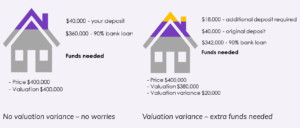You’ve taken the first steps to getting into your new home. The land is chosen, and you have the perfect floor plan. Then imagine you’re about to sign contracts when the bank calls: you need to find some more funds to make your dream a reality.
Valuation variance, as it’s called in the finance world, is something that can hit first home buyers out of left field, but it’s something that can be managed with some smart decisions early on, and by working with a reputable builder and trusted finance partner.
What’s a valuation variance anyway, and why’s it important?
When it comes to buying a first home, most people have a deposit ready but will need to take out a home loan to fund the purchase. For example, if the price of your new house and land is $400,000, and you have a 10% deposit ($40,000), you will need a loan of $360,000 – which is 90% of the property’s value – plus fees.
Before handing over any funds though, your bank or lender will seek an independent security valuation on your new home. This is because your home is the security against the home loan and if you default and your house needs to be sold, they need to be confident the sale price (after realty fees) will cover off your debt in full.
To value your home, your lender will look at comparable sales in your area. For example, if your new home is set to be 3 bedrooms, 2 bathrooms, double garage and single story, they will look for similar properties near you that have sold in the past 6 months, to estimate the market value.
If your lender independently values your new home at $400,000, then you’re good to go and they will lend you the $360,000 you need to buy your house and land (and provided you meet their standard lending criteria).
However, if recent sales of comparable established homes in surrounding areas have been selling for around $380,000, they may put a value of $380,000 on your home too. A variance now exists as you are paying $400,000 for your new home to be built to your personal design and specifications, in the area you have chosen. This difference means the bank will likely only give you a loan for $342,000 (which is 90% of the value). Combined with your $40,000 deposit, you will only have $382,000. You will need to find an additional $18,000 to complete your purchase of your house and land of $400,000.
Valuation variance explained

It’s certainly not unusual to see differences in prices between ‘new’ and ‘established’ houses in a similar market. Their prices don’t always move in unison, but overtime, they will tend to align. So if the price of established houses is falling but the price of new builds is rising, you may incur a valuation variance – which, as we explain below, can be managed.
Tips to help manage valuation variance
Many first homes are a stepping stone to future homes, so when you’re planning your house, it’s important to keep in mind its future resale value, and it’s important to stay vigilant, when you have a minimum deposit.
‘Over capitalising’ is a term you’ve likely heard a lot – and it’s something to avoid. It happens when you spend a lot of extra money on features or finishes that future buyers may not value or want to spend extra for.
Here are some suggestions to help you reduce your costs, without compromising value:
- Remove expensive upgrades and promo items that are ‘nice to have’, like stone bench tops, an ensuite spa, European appliances or plantation shutters
- Reduce pre-start allowance to reduce the overall contract cost
- Be flexible with your room types. For example, make allowance for a wardrobe in a study, or add doors to a theatre room, so either could double as a fourth bedroom
On the flip side, here are some items that you should consider including in your contract to demonstrate the value you’re building into your new property. These types of items demonstrate to the lender that your home will be ‘complete’ at handover:
- Carpets
- Curtains
- Light fittings
- Wall painting
Know your area
Knowing the style and size of home that’s common in your neighbourhood is important when you’re looking to avoid a valuation variance. As mentioned, to value your home, your lender will look at comparable sales in your area. If homes in the area are predominately four bedrooms with two bathrooms, it’s reasonable to expect that most purchasers looking to move into the area will also be looking for ‘four by two’ homes to buy. Any home that’s materially different may take longer to sell as the number of people looking to buy it will be less. This means when your house is being valued for your loan, there could be less comparable data and more room for valuation variances.
Your builder and mortgage broker will work closely with you throughout your home ownership journey and try to help you avoid a valuation shortfall, or help to manage one, if it occurs.
Building a new home is exciting and knowing what to expect up front will help keep the journey smooth and enjoyable.